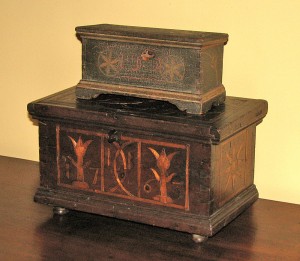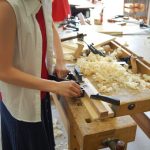We may receive a commission when you use our affiliate links. However, this does not impact our recommendations.
 I’ve spent the last few months staring at photographs of pieces from the Museum of Early Southern Decorative Arts (MESDA) collection, while working on the drawings for our new book. While Glen D. Huey and I have great resources to work with, there have been times when we haven’t been quite sure of what we’re looking at. It’s detective work, and part of coming up with an answer is to imagine what the original maker was like; why would a guy go to a lot of trouble to do an intricate detail and then take the easy way out in another part of the same piece?
I’ve spent the last few months staring at photographs of pieces from the Museum of Early Southern Decorative Arts (MESDA) collection, while working on the drawings for our new book. While Glen D. Huey and I have great resources to work with, there have been times when we haven’t been quite sure of what we’re looking at. It’s detective work, and part of coming up with an answer is to imagine what the original maker was like; why would a guy go to a lot of trouble to do an intricate detail and then take the easy way out in another part of the same piece?
Many of the details we’ve found are things that generally wouldn’t be accepted as good practice today, but we’re looking at pieces that are a couple of hundred years old. Maybe the rules we use today are more flexible than we’ve been led to believe by those who write them down.
We’ve seen evidence of mid-project “design changes”. What do you do when you’ve made a lot of progress on a project, and you hit a point where you realize you made an error in judgment three or four steps back? Do you toss a piece that you’ve invested a substantial amount of time in, or do you adapt and hope no one will notice?
While working on the drawings for the inlaid box at the bottom of the photo, I came across a detail that showed that the maker was completely human. It took a while for me to figure out what was going on, and I decided to post the picture that puzzled me for a few hours, and see if our readers can explain it.
This is the inside of the box, made in Maryland in 1763. Overall it is about 9 1/2″ deep, 9 1/2″ tall and 16 1/2″ wide. The till is a small box within the box, has a hinged lid and occupies the upper left hand corner of the box’s interior. In the photo, there is a clue about how the front and bottom of the till connect to the front and back of the box. The same clue tells us how the lid of the till is hinged, and it also tells us something about the maker. Rather than spoil the fun with my explanation, take a close look at the photo and leave your explanation as a comment.
Ten years ago, my first book of measured furniture drawings was published. You can find Shop Drawings for Craftsman Furniture in our store.
Here are some supplies and tools we find essential in our everyday work around the shop. We may receive a commission from sales referred by our links; however, we have carefully selected these products for their usefulness and quality.










Most of the readers guessed correctly (and a lot faster than it took me to get it) that the original maker made one of the classic flubs in woodworking. Below the till are two grooves at a right angle to each other, and a hole for a dowel that acts as a hinge for the lid of the till.
Somewhere along the line, likely in laying out the grooves, the maker neglected to realize that while the layout for the front and the back inside are essentially the same, they are mirror images of each other. The back was cut the same as the front, and if the piece we see were flipped end for end the grooves for the till would be in the upper right of the picture instead of the lower left.
My guess is that the dovetails were cut first, then the grooves for the till let in. If that’s the case, the original maker was having a really bad day when he laid out the grooves as he was not only backwards but upside down as well.
The back of this little box is plain-no inlays and the molding stops at the end of the sides. Replacing the back would have meant preparing a new piece and re-cutting the dovetails. The extra set of grooves and hole probably aren’t as visible in real life as the photo suggests, and who would have thought of being subjected to scrutiny like this far off in the future?
The gains for the hinges need to be there for the straps to clear.
Bob Lang
Perhaps Mr. Lang will return someday and let us know if any of our assumptions were correct.
simple case of getting turned around. Thought the back was the front, or vice versa. I can, does, and will happen to us all. No big deal for me. I’d leave it (unless I was going to give it to the Queen of England, or something). The best woodworkers I know aren’t any better at building than I am. They’re better at covering up their mistakes than I am. ;-p
I didn’t want to read the other posts. It takes the fun off this game, so forgive me if this has been written lots of times already:
I think the maker built a front piece first, and then, by mistake, he built the back with the grooves for the small inside box, exactly in the same place… he forgot to mirror the placement for the grooves and the hole for the hinge. It is hard to say what I would have done, because I don’t know how much work had been done on the back already… is it dovetailed to the sides? does it have inlay work on the outside, on the back piece?
I could have either made a new piece, or cover the inside of the back with a 1/8 to 1/16 thick veneer to hide the mistake.
Pedro L. in Portugal
Yeah, I gotta agree with Dean, he just had his layout reversed, been there-done that. Probably figuired no one will see it when the box is full of whatever they stored in it. I’m sure Mark is right, had he known this many people were going to see it, he’d of thrown it away, and made another piece. Which is what I’ve normally done, however after seeing this…will definitely always do!
Who hasn’t done this before! Ooops I just used the back as the front and cut in the wrong grooves… Oh well, fill it in with a glue/sawdust combo and cover it with a piece of veneer then match it all with a nice finish or line it with leather! Not only done nicely but now it’s a deluxe box with a till!
The craftsman made two identical parts and had to adjust when they realized the mistake. I would guess they did the inlays first and that is why they made the adjustment and not start over.
He cut his dovetails wrong for the bottom panel and had to turn the piece over.
The grooves for the till are cut in the wrong part of the back panel. Oops.
Changed his mind about the hinge mortices. Began on top, then realised that they were to go on the rear.
Regards from Perth
Derek
I can just imagine the original craftsman thinking: “ah, not too many people will notice this.” If he’d have known his mistake would be posted on the internet (and had photography, digital telephony and internetworking concepts explained to him), maybe he’d have started over on the piece.
I have to agree with Dean, the maker just installed the back panel 180 degrees from where he intended. And rather than start over he just “made adjustments” (i.e. design changes). Also, a lot of the tills I’ve seen have been at the top left so that might also be another reason it was ultimately placed there.
Looks to me the maker cut his boards, then carved and inlet for the till and cut his dovetails last not paying attention to the carving and till relationship. And re-inlet the till in it’s proper place as the least visible correction to his mistake.
Norm
I wonder if the groove/dado and dowel hole are also mirrored beneath the till on the front of the box. If so, I would guess that the till was originally intended to be installed on the right side, but the carving on the front was done upside-down, after the joinery had been cut. If there is no corresponding miss-cut on the front then I’m guessing he just cut joinery for two front panels, instead of a front and a back.
So how would you fix this, if it were your box (and you didn’t want to leave it)? I’m guessing some would cut wood to infill the gaps. Perhaps you could fill it and apply flocking. I’m not sure when flocking was first used.
Looks like the back panel was turned upside down. I’m not sure which side of the box the till was originally intended to be on, but based on the grooves below the current till, it would have been on the top right. By turning the back piece upside down, the grooves were more out of sight and the till being on the top left helps to partially hide the original grooves. The clue for me was the small hole drilled in the back to receive the dowel being used as a “hinge” mechanism. I can see the small dowel hole by the exposed grooves in the lower left corner under the till box.
Bob,
It looks like the original builder simply botched the layout. He laid out the back of the till like it was the front (or just made two fronts) and thus there is a dado/mortise below the till in the back. I believe we have all been there at some point or another.
Josh